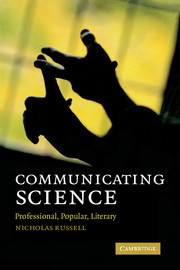Book contents
- Frontmatter
- Contents
- Introduction: What this book is about and why you might want to read it
- Prologue: Three orphans share a common paternity: professional science communication, popular journalism and literary fiction are not as separate as they seem
- Part I Professional science communication
- Part II Science for the public: what science do people need and how might they get it?
- Part III Popular science communication: the press and broadcasting
- Part IV The origins of science in cultural context: five historic dramas
- Part V Science in literature
- 20 Science and the Gothic: the three big nineteenth-century monster stories
- 21 Science fiction: serious literature or low grade entertainment?
- 22 Science in British literary fiction
- 23 Science on stage: the politics and ethics of science in cultural and educational contexts
- Index
- References
20 - Science and the Gothic: the three big nineteenth-century monster stories
Published online by Cambridge University Press: 02 December 2010
- Frontmatter
- Contents
- Introduction: What this book is about and why you might want to read it
- Prologue: Three orphans share a common paternity: professional science communication, popular journalism and literary fiction are not as separate as they seem
- Part I Professional science communication
- Part II Science for the public: what science do people need and how might they get it?
- Part III Popular science communication: the press and broadcasting
- Part IV The origins of science in cultural context: five historic dramas
- Part V Science in literature
- 20 Science and the Gothic: the three big nineteenth-century monster stories
- 21 Science fiction: serious literature or low grade entertainment?
- 22 Science in British literary fiction
- 23 Science on stage: the politics and ethics of science in cultural and educational contexts
- Index
- References
Summary
We have seen in Part IV that some seventeenth- and eighteenth-century authors treated the precursors to science (magic, alchemy and natural philosophy) with considerable cynicism. Science did not get off to a good literary start and Haynes has shown that Western literary culture continued to view science in a poor light. This literary image of science was further blackened by its role in three of the best-known and long-surviving nineteenth-century horror stories, which are constantly retold in new stage and screen adaptations.
These are Mary Shelley's Frankenstein or the Modern Prometheus (1818 and revised in 1831), Robert Louis Stevenson's Strange Case of Dr Jekyll and Mr Hyde (1886), and Bram Stoker's Dracula (1897). The overall conclusion from these stories is that science can lead to horrible consequences, exemplified by acronyms like ‘Frankenfoods’ to describe foodstuffs prepared from genetically modified crops. But the associations in these stories were initially more subtle, the science often being a force for good, rather than a cause of evil. The ambivalent position of science in these stories mirrors the ambivalent relationship between reason, progress and good government in so-called Enlightenment thought in the eighteenth and nineteenth centuries, and its antithesis in traditional, aristocratic and reactionary government epitomized by feudalism. The literary expression of the tensions between progress and reaction is the Gothic; in which horror is often associated with science. […]
- Type
- Chapter
- Information
- Communicating ScienceProfessional, Popular, Literary, pp. 247 - 261Publisher: Cambridge University PressPrint publication year: 2009



